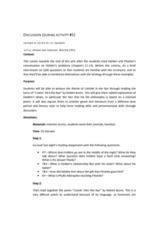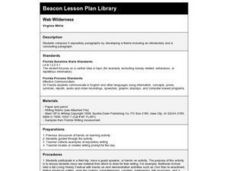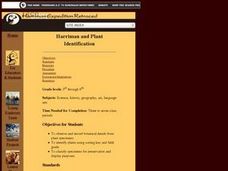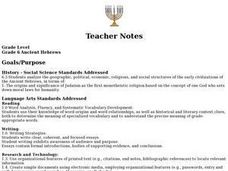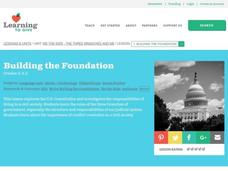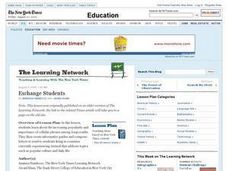Curated OER
The Catcher in the Rye: Chapters 21-23
After answering comprehension questions (good for a homework reading check), class members analyze "Comin' Thro the Rye," and using the included guidance questions, discuss Holden's misreading of Robert Burns' poem. The URL to text of...
National Endowment for the Humanities
A “New English” in Chinua Achebe’s “Things Fall Apart”: A Common Core Exemplar
To examine the “New English” Chinua Achebe uses in Things Fall Apart, readers complete a series of worksheets that ask them to examine similes, proverbs, and African folktales contained in the novel. Individuals explain the meaning...
National Endowment for the Humanities
“Twelve Years a Slave”: Analyzing Slave Narratives
Readers of Solomon Northup's brutally frank slave narrative Twelve Years a Slave examine passages that support the argument that slavery "undermined and corrupted" the institution of marriage. Background information is provided by a...
Mathematics Assessment Project
Representing 3-D Objects in 2-D
How does the shape of the surface of water in a container change as water leaks out? After tackling this question, learners take part in a similar activity with more complex figures.
American Documentary
The Benefits and Drawbacks of Plea Bargains
The outcome of 90 percent of criminal cases in the US is determined by plea bargains. Clips from the documentary Better This World create the backdrop for an investigation of the benefits and drawbacks of the plea bargaining process....
Federal Reserve Bank
Credit Reports—and You Thought Your Report Card Was Important
Get the facts about credit and take a close look at what factors into a consumer credit report with this fantastic lesson. Your pupils will read informational texts, read sample financial documents, and discuss the advantages and...
National Wildlife Federation
What is DBH?
When measuring the circumference of a tree, does it matter how high you place the measuring tape? Most scholars have never considered this question, but scientists know that measurement techniques must be standardized. The 13th...
Curated OER
Reading/English Language Arts/ Instructional Strategies
Students are given a line drawing that only that students sees. They are asked to describe the drawings to the reset of the class to see if they can draw it as the teacher describes it. Students work with a partner, and they are given a...
Curated OER
Reading a Map
Third graders become familiar with the vocabulary and skills related to mapping. In this guided reading lesson, 3rd graders find proper nouns on from the map. Students read Goldilocks. Students make a map of their room.
Curated OER
Geo Jammin'-Day2, Lesson 7: Roll, Roll, Unroll the Scroll
Second graders write in journals, recording personal thoughts about what they learned and/or something they are wondering about.
Curated OER
Web Wilderness
Fourth graders write an expository paper using notes taken during a field trip or a guest speaker.
Curated OER
President Obama's Address to Students Across America
Students write about goals, responsibility, and persistence, and listen to President Obama's speech. In this President Obama lesson students create concept webs, listen with a purpose, and list the challenges of our generation.
Curated OER
Harriman and Plant Identification
Students observe and record botanical details from the plant specimens. They identify plants using sorting key and field guide and classify specimens for preservation and display purposes.
Curated OER
A Pixie Biography Report
Students practice biographical writing after completing research on the subject. In this journalism instructional activity, students read a story of an important person's life and discuss the important moments along the way. Students...
Curated OER
Does One Tree a Forest Make?
Students take a walk around the schoolyard looking at and identifying the trees. One leaf for each tree is collected. A chart is developed that represents the population of trees on the school ground. They keep journals and write an essay.
Curated OER
Portfolio Autobiographies
Third graders create an autobiography on the computer. They write, design and illustrate using word processing and graphic tools on the computer.
Curated OER
New Year Celebrations in China (Chun Jie)
Fifth graders compare and contrast the traditions and customs of the holiday with those in Korea and Japan. They express themselves with few non-native grammatical errors in speaking and writing; develop and use background...
Curated OER
Charlotte's Web
Fourth graders focus on fluency by reading the book Charlotte's Web. In this reading strategies lesson plan, 4th graders partner read, do guided reading, and independent reading to increase fluency. Students use Venn Diagrams, discuss...
Curated OER
Ancient Hebrews
Sixth graders analyze the geographic, political, economic, religious, and social structures of the early civilizations of the Ancient Hebrews, and write an essay.
Curated OER
Take Me To Your National Park
Young scholars describe the purposes of national parks as a part of our American heritage. They identify and describe important national park sites in a specific state. They write a journal entry or paragraph about why national parks...
Curated OER
Building the Foundation
Students understand the purpose of the judicial branch of government. In this judiciary lesson, students participate in exercises to understand how the court system works. Students complete activity sheets to develop understanding of...
Curated OER
Exchange Students
Students discuss as a class the items they value and why. They read an article about the popularity of cellphones in Iraq. In groups, they work together to create a guide to their culture to share with others visiting their classroom....
Curated OER
Pendemonium - The Posse in Australia
Students revise letters focusing their revision on comma and periods usage. In this creative grammar lesson, students watch a video on commas and periods, write a letter to a partner without the use of commas or periods, and revise a...
Curated OER
A World of Myths
Students read and write myths. In this world mythology instructional activity, students read and analyze myths from various cultures and then recognize their attributes as they write their own myths to explain natural phenomena.


